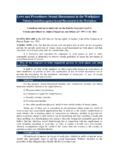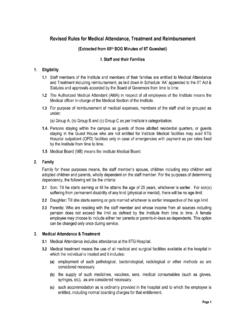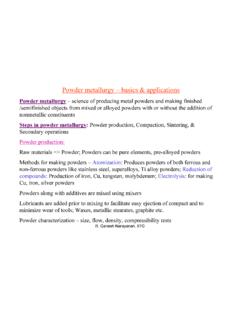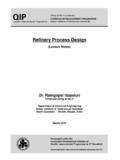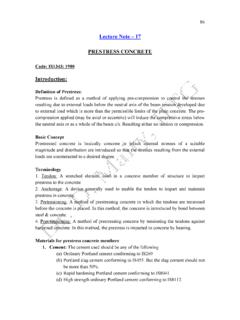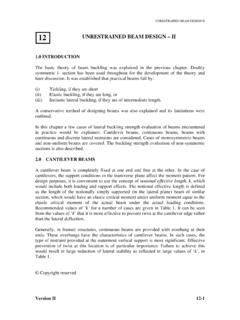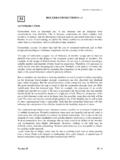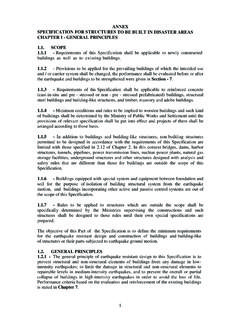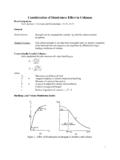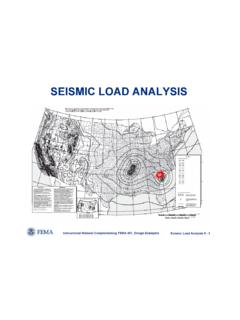Transcription of Lecture – 1 Design Philosophy
1 Lecture 1 Design Philosophy Working Stress Method of Design Concrete is strong in compression and crushing strength is determined by test on standard cubes. Large deformation is noticed at the failure load. Deformation is permanent in nature. This suggests for the adoption of a factor of safety. Permissible bending & direct compression are as fraction of crushing strength. For example: M15 concrete, the value of cbc = 5 = (15/3) and cc = 4 = (15 ) Assumptions in working stress method 1. Plane section before bending will remain plane after bending. 2. Stress-strain relations obey Hooks law (linear) 3. Tensile stresses are taken by steel only. =csEEmcbc 3280= m not as 4. The Modular ratio5. cbf= Compressive stress of concrete; cbc =Permissible stress of concrete; stf = Tensile stress in steel ; st = Permissible stress of concrete 2 Limit State Method of Design This is based on the behavior of structure at different limit states ensuring adequate safety against each limitation.
2 1. Ultimate Limit State: With respect to strength in shear, flexure, torsion, bond or combined effects. 2. Serviceability Limit State: With respect to deflection & cracking. The appearance, durability and performance of the structure must not be affected by deflection & cracking. Assumptions in limit state method: 1. Plane section before bending will remain plane after bending. 2. Tensile strength carried by of concrete is zero. 3. Does not obey Hook`s law. 4. Ultimate strain of concrete is Partial safety factor for concrete Hence, Design strength of 5. Maximum strain in tensile reinforcement at failure shall not be less +syEf 6. Partial safety factor for steel . Thus the Design strength will be: 3 4 Balanced section: Compression strain in concrete = Tensile strain in steel = yield strain Under Reinforced Section: Compression strain in concrete < Tensile strain in steel = yield strain Over Reinforced section: Tensile strain in steel < yield strain Compression strain in concrete = Under Reinforced Section is Preferable 5 Lecture Note 2 Modeling of Wind Loads IS-875 Part-I DL Part-2 LL Part-3 WL Part-4 Snow Load Part-5 Special loads & load combinations IS:1893 Earthquake load Exceptional load Due to cyclone, earthquake.
3 Dynamic super imposed load Vibration & impact caused by machinery & mobile equipments such as crane etc. IRC Bridge code Load due to imposed deformations. 1. Shrinkage, temperature & prestressing. of supports Factored Designed load =Load Partial safety factor. For DL & LL Partial safety factor = Ultimate limit state = For Serviceability limit state Wind load In 1700 Century, WL= kN/m2 (V= Up to 45 mph) = kN/m2 (V= 45-60 mph) = kN/m2 (V= over 60 mph) In early 1900 Century 221vp = Bernoulli s equations Where, p Pressure Density of air Kg/m3 v Steady velocity of air 6 Indian Code for wind loads There are 6 zones in India having basic wind speed of 33, 39, 44, 47, 50 & 55 m/s. 55 m/s.
4 Only Silchar & Ladakh Hilly Area Design Wind speed 321kkkVVbz= Where, Design wind speed in m/s at height Z zVbV Basic wind speed. 1K Probability factor or risk factor. 2K Factor for the combined effects of terrain height & size of the component on structure. 3K Factor for local topography ( hills, valleys etc.) 1K Table -1 of IS-875 part-3 K2 Depends on a) Type of terrain. b) Height of building c) Size of structure K2 is given in Table-2 Type of terrain Category 1: Exposed open terrain with no obstruction. Category 2: Open terrain with scattered obstruction of height between to 10m. Category 3: Terrain with numerous low rise (10m) obstructions.(Outskirts of City) Category 4: Terrain with numerous high rise obstructions.(City centre) Size of Structure Depends on the largest dimension of structure for different Class Class A: Structure & components such as cladding , glazing, roofing etc.
5 Having maximum dimensions less than 20m. Class B: Structure & components as above with maximum dimension 20m to 50 m. Class C: Structure & components as above with maximum dimension greater than 50 m. In USA , UK following formula is used to calculate the velocity 7aoghhhVV = Where, Velocity at height h. hV Velocity at ground. gV Height of the ground. oh Height of the structure . h From 1/10 to 1/12 depending upon site conditions. a Value of the topography factor 3K Topographical features such as hills, valleys, cliffs, significantly alter the wind speed. K3 = if 03< = to if 03> From IS:875 8eL=Effective horizontal length eL=L when 00173to= = when 017> Where, L= Horizontal length of the upwind slope. Z= Effective height of the feature. =Upwind slope in the wind direction. 31sKC=+ (for to 1703= 0) = (for ) 017> S = A function of distance ratioeLX and the height ratio eLH of the point being considered.
6 9 Wind Effects on Structure Static & Dynamic effects of wind on Structure Type of Structure Effect of Wind stiff structure like low rise building. structure like chimneys, tall buildings with natural frequency greater than that of wind. structure with natural frequency equal to that of the fluctuating part of the wind. A. No deflection. B. Pressure quasi-static. A. Structure deflects. B. Pressure dynamic. C. Resonance effect nil. Both along & across wind effects are possible. A. Structure undergoes large deflection. B. Effects of deflection can be larger than wind effect. C. Resonance with damping. Both along & across wind effects are possible. Clause of IS 875 Part-3 7. DYNAMIC EFFECTS General - Flexible slender structures and structural elements shall be investigated to ascertain the importance of wind induced oscillations or excitations along and across the direction of wind. 10In general, the following guidelines may be used for examining the problems of wind induced oscillations: a) Buildings and closed structures with a height to minimum lateral dimension ratio of more than about and b) Buildings and closed structures whose natural frequency in the first mode -is less than Hz.
7 Any building or structure which does not satisfy either of the above two criteria shall be examined for dynamic effects of wind. NOTE 1 - The fundamental time period (T) may either be established by experimental observations on similar buildings or calculated by any rational method of analysis. In the absence of such data, T may be determined as follows for multi-storeyed buildings: a) For moment .resisting frames without bracing or shear walls for resisting the lateral loads T-= n Where, n = number of storeys including basement storeys; and b) For all others Where, H - total height of the main structure of the building in metres, d = maximum base dimension of building in metres in a direction parallel to the applied wind force. Design wind pressure zp Design wind pressure in N/m2at height Z. Design wind velocity in m/s at height Z. Wind pressure and force on structure The wind load on a structure shall be calculated for : a) The building as a whole Using pressure coefficient.
8 B) Individual structural elements as roofs & walls. Using force coefficient. 11 Effect of Wind on Structure The internal pressure depends on the locations & size of the openings. 1. Pressure coefficients for components Pressure coefficients are given in Table 4 to 22. Force =()pACCpipe Clause (pp-13) 2. Force coefficient for structure as a whole Force =efAC C Force coefficient Table-23 feA p Pressure Effective area of the building. 12 Lecture Note 3 Wind Load on Buildings Example: A reinforced framed building is 45 15 m in plan and 60 m in height consisting of storeys 4m in height. It is braced in the longitudinal direction by rigid frame action and by a reinforced concrete infill wall in the transverse direction. Determine the Design wind force on the framed building. Assume that the building is situated in terrain category 3 with basic wind speed of 50 m/s in a fully developed velocity profile.
9 Solution: Step1: Data Plan of building = 45 15 m; height =60 m Basic wind speed =50 m/s Step2: Find the Design wind speed zV321kkkVVbz= Risk factor ; Topography factor Factor depends upon the following: 2ki) Terrain category 3 ii) Structural size factor greater horizontal or vertical dimensions is larger than 50 m . 15 m gust size is appropriate. Hence class C. Read off for terrain category 3 and class C for varying heights, the value of . 2k2kFor convenience, the heights is divided into three divisions & the greater value for each division is used, (0-20 m,20-40 m, and 40-60 m) Step 3: Determine dynamic pressure for different heights Pressure [Ref. clause of IS:875] Table 1(From Table 2 of IS:875) Interval (max) (m/s) p(N/m2kzV2) 0-20 1242 20-40 1500 40-60 1622 13 Step4: Calculate the force coefficients fCLet, Wind be normal to 45 m base = wind at 00.
10 Wind be normal to 15 m base = wind at 900 a = Depth of plan dimension=15 m b = Dimensions on which wind at 00 acts =45m h =Height=60 m Table 2 (from fig. 4 of IS:875) Dimension wind at 00 wind at 900 a/b 15/45= 45/15= h/b 60/45= 60/15= Cf Step5: Determine forces of wind at 00. Wind force =(Area) fpCArea = 45 (Floor height of 4m) ()454453. for each meter of length. UDL on floor slab =Tabulating for the intervals adopted. Table 3 Interval p(N/m2) Force(KN/m) 0-20 1242 20-40 1500 40-60 1622 Step 6: Determine wind forces in 900 direction.
